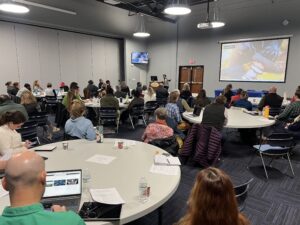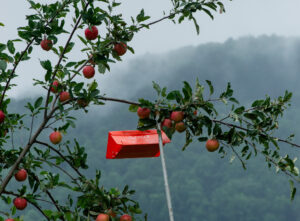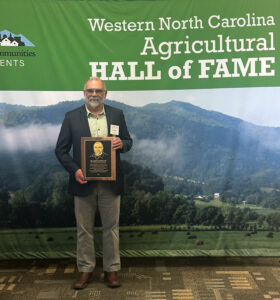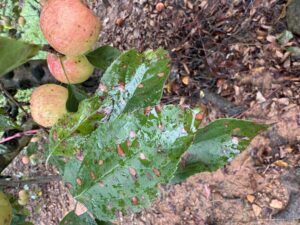
Join Us for the 2025 NC Produce Safety Professionals Conference!
The North Carolina Fresh Produce Safety Task Force invites produce growers, food safety coordinators, extension agents, food safety consultants, …


El inglés es el idioma de control de esta página. En la medida en que haya algún conflicto entre la traducción al inglés y la traducción, el inglés prevalece.
Al hacer clic en el enlace de traducción se activa un servicio de traducción gratuito para convertir la página al español. Al igual que con cualquier traducción por Internet, la conversión no es sensible al contexto y puede que no traduzca el texto en su significado original. NC State Extension no garantiza la exactitud del texto traducido. Por favor, tenga en cuenta que algunas aplicaciones y/o servicios pueden no funcionar como se espera cuando se traducen.
Inglês é o idioma de controle desta página. Na medida que haja algum conflito entre o texto original em Inglês e a tradução, o Inglês prevalece.
Ao clicar no link de tradução, um serviço gratuito de tradução será ativado para converter a página para o Português. Como em qualquer tradução pela internet, a conversão não é sensivel ao contexto e pode não ocorrer a tradução para o significado orginal. O serviço de Extensão da Carolina do Norte (NC State Extension) não garante a exatidão do texto traduzido. Por favor, observe que algumas funções ou serviços podem não funcionar como esperado após a tradução.
English is the controlling language of this page. To the extent there is any conflict between the English text and the translation, English controls.
Clicking on the translation link activates a free translation service to convert the page to Spanish. As with any Internet translation, the conversion is not context-sensitive and may not translate the text to its original meaning. NC State Extension does not guarantee the accuracy of the translated text. Please note that some applications and/or services may not function as expected when translated.
Collapse ▲
The North Carolina Fresh Produce Safety Task Force invites produce growers, food safety coordinators, extension agents, food safety consultants, …
![Cover photo for 2025 Apple Maturity Pilot Program [10.16.2025]](https://apples.ces.ncsu.edu/wp-content/uploads/2025/10/25PAM-Group-Pic-_Pink-Lady-Mike-Parker-221x300.png)
In cooperation with the Henderson County Master Pomology Program, we initiated an effort to monitor apple fruit maturity in …
![Cover photo for 2025 Apple Maturity Pilot Program [10.08.25]](https://apples.ces.ncsu.edu/wp-content/uploads/2025/10/25PAM_PLady_Granddad_Grouped-Pics_10.7.25-227x300.png)
In cooperation with the Henderson County Master Pomology Program, we initiated an effort to monitor apple fruit maturity in …
![Cover photo for 2025 Apple Maturity Pilot Program [9.30.25]](https://apples.ces.ncsu.edu/wp-content/uploads/2025/09/25PAM_Evercrisp_Grouped_9.30.25-205x300.png)
In cooperation with the Henderson County Master Pomology Program, we initiated an effort to monitor apple fruit maturity in …
![Cover photo for 2025 Apple Pilot Maturity Program [9.23.25]](https://apples.ces.ncsu.edu/wp-content/uploads/2025/09/25PAM_AztecFuji_GroupedPic_9.23.25-1-192x300.png)
In cooperation with the Henderson County Master Pomology Program, we initiated an effort to monitor apple fruit maturity in …
![Cover photo for 2025 Apple Pilot Maturity Program [9.17.25]](https://apples.ces.ncsu.edu/wp-content/uploads/2025/09/25PAM_Granny_Grouped_9.16.25-1-210x300.png)
In cooperation with the Henderson County Master Pomology Program, we initiated an effort to monitor apple fruit maturity in …
![Cover photo for 2025 Apple Maturity Pilot Program [9.10.25]](https://apples.ces.ncsu.edu/wp-content/uploads/2025/09/25PAM_RedDel_GroupedPic_9.9.25-2-203x300.png)
In cooperation with the Henderson County Master Pomology Program, we initiated an effort to monitor apple fruit maturity in …
![Cover photo for 2025 Apple Pilot Maturity Program [9.04.25]](https://apples.ces.ncsu.edu/wp-content/uploads/2025/09/25PAM_RedDel_Grouped-Pic_9.2.25-207x300.png)
In cooperation with the Henderson County Master Pomology Program, we initiated an effort to monitor apple fruit maturity in …

Little has changed in insect activity during the past week, with trap captures continually being low or on the …
![Cover photo for 2025 Apple Maturity Pilot Program [8.27.25]](https://apples.ces.ncsu.edu/wp-content/uploads/2025/08/25PAM_RedDel_Grouped_8.26.25-204x300.png)
In cooperation with the Henderson County Master Pomology Program, we initiated an effort to monitor apple fruit maturity in …

With the exception of the brown marmorated stink bug (BMSB), trap captures of key pests declined during the past …
![Cover photo for 2025 Apple Maturity Pilot Program [8.21.25]](https://apples.ces.ncsu.edu/wp-content/uploads/2025/08/25PAM_Gala_8.19.25_Grouped-213x300.png)
In cooperation with the Henderson County Master Pomology Program, we initiated an effort to monitor apple fruit maturity in …

Codling moth and oriental fruit moth (OFM): With the exception of locations that have had high codling moth problems …
![Cover photo for 2025 Apple Maturity Pilot Program [8.13.25]](https://apples.ces.ncsu.edu/wp-content/uploads/2025/08/25PAM_Honey-Crisp_8.12.25_-GroupPic.jpg-203x300.png)
In cooperation with the Henderson County Master Pomology Program, we initiated an effort to monitor apple fruit maturity in …

During the past week, codling moth and apple maggot numbers in traps have slightly declined, oriental fruit moth (OFM) …

Congratulations to Dr. Jim Walgenbach, who was inducted last Friday into the WNC Ag Hall of Fame! The WNC Community …
![Cover photo for 2025 Apple Maturity Pilot Program [08.06.25]](https://apples.ces.ncsu.edu/wp-content/uploads/2025/08/Honeycrisp-skin-cracking-e1754653818716-300x225.jpg)
In cooperation with the Henderson County Master Pomology Program, we initiated an effort to monitor apple fruit maturity in …

The recent cool weather has slowed insect development, and consequently not much has changed in the past week. Codling …

They say a picture is worth 1000 words, but maybe sometimes it’s just better to keep words unsaid….At the …
![Cover photo for 2025 Apple Maturity Pilot Program [07.30.2025]](https://apples.ces.ncsu.edu/wp-content/uploads/2025/07/25PAM_GingerGold-Group-Pic_7.29.25-213x300.png)
In cooperation with the Henderson County Master Pomology Program, we initiated an effort to monitor apple fruit maturity in …